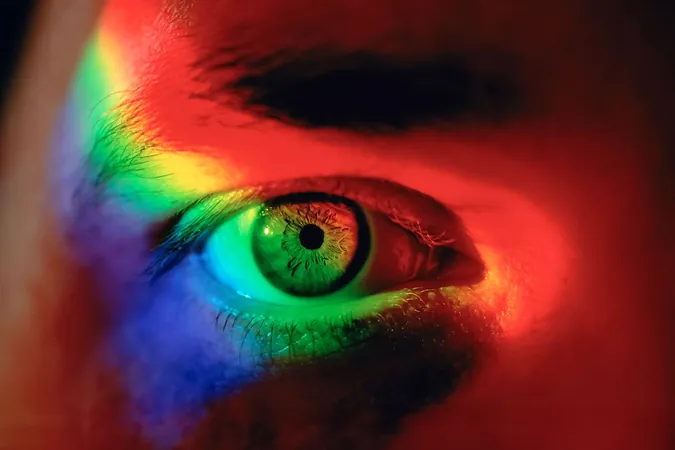
The Enigmatic Essence of Color: Is It Real or Just a Construct of Our Perception?
2024-11-16
Author: Emma
What if I told you that everything you thought you knew about color is only scratching the surface? As we dive into this multifaceted topic, we unravel the complexities of what color truly is, all while challenging our long-held beliefs.
At the core of our understanding of color lies the mechanism of light. White light can seem harsh and blinding, yet it holds within it a spectrum of wavelengths that define the very essence of color. Think of why leaves are green: they efficiently absorb sunlight wavelengths for photosynthesis, while the blue sky owes its hue to light scattering in the atmosphere. Nevertheless, despite centuries of inquiry, the true nature of color remains one of life's most tantalizing mysteries.
Historically, philosophers have debated the existence of color. Democritus proposed that color arises from the way light refracts through atoms, whereas Aristotle adored the idea that color is an inherent quality of objects. Fast forward to the scientific upheaval of the 17th century, when color was largely deemed an illusion, a secondary quality devoid of any substantial role in the mechanics of the physical universe. David Hume even called it “the phantasm of the senses,” which begs the question: Is color really just a figment of our imagination?
How We Perceive Color
The education system teaches us that the rainbow consists of red, orange, yellow, green, blue, and violet colors. However, much of what we learn is misleading. For instance, the idea that primary colors—red, yellow, and blue—can blend into any color is a misconception; color mixing often results in muted, muddy shades.
Interestingly, our eyes and brains collaborate to interpret colors using rods and cones—light-sensitive cells found in our retinas. While humans possess three types of cone cells for color discrimination, other species experience an entirely different palette. Creatures like bees can see shades of ultraviolet, indicating that there are colors existing beyond human perception. For example, certain flowers have evolved patterns visible only to pollinators, presenting an array of colors humans cannot fathom.
Similarly, certain snakes, like pit vipers, utilize infrared light to detect heat, effectively giving them a unique hunting edge. Some studies show that humans can perceive infrared light as a very faint color, challenging our definitions further.
Our Subjective Reality
Color perception is influenced by our brains interpreting various light wavelengths. This crux of perception varies not only from person to person but can change within individuals over time due to development, disease, or even mood. Such individual differences lend credence to the notion that while we may describe a sunset as “orange” or “red,” our internal experiences could be vastly different.
Dr. Mohan Matthen, a philosopher, suggests our eyes are not perfect spectrometers, hence the variations in perception. This unpredictable facet is essential. A recent study from MIT posits that our grayscale beginnings as infants might offer us resilience in distinguishing subtle colors in the future, whereas those who see color from birth may depend more on absolute hues.
Moreover, cutting-edge research implies that accepted models of color perception may overestimate our ability to differentiate between hues. This revelation demands the question: What more could we be misunderstanding about our perceptions?
The Color Debate
As we navigate the debate surrounding the existence of color, extremes emerge. Color realism posits that objects possess inherent color traits, while color fictionalism suggests color is a mere figment of our collective imagination. On the spectrum of perception, reality-based theories seek a middle ground: colors exist, but their links to the world are less direct than previously thought.
Thought leaders argue that culture and learned experiences shape our perceptions of color, leading to the idea that color is far more subjective than previously imagined. The question, “Is my red the same as your red?” highlights the enormous implications on consciousness and reality; it invites us to contemplate that each person might be inhabiting a totally different experience.
Despite the blurry edges around our understanding of color, we can find comfort in a shared dialogue about its significance. Similar emotional associations, like warmth and coolness linked to color, suggest an underlying connection in our experiences.
Conclusion: A Colorful Mystery
While color may evade simplistic definitions, it remains an essential aspect of our existence. Investigating what colors mean in a wider context illuminates the threads that intertwine perception, reality, and consciousness. Perhaps the real beauty of color lies not solely in its visual grandeur but also within the depths of our very own experiences.
As we ponder the boundaries of color perception, we open ourselves to the questions of existence and consciousness itself. So next time you gaze upon a sunset, remember: what you see might not be what others see, yet that very mystery enriches the human experience. The world of color may not simply be real or imagined; it might be a little bit of both—forever fascinating, ever elusive.









 Brasil (PT)
Brasil (PT)
 Canada (EN)
Canada (EN)
 Chile (ES)
Chile (ES)
 Česko (CS)
Česko (CS)
 대한민국 (KO)
대한민국 (KO)
 España (ES)
España (ES)
 France (FR)
France (FR)
 Hong Kong (EN)
Hong Kong (EN)
 Italia (IT)
Italia (IT)
 日本 (JA)
日本 (JA)
 Magyarország (HU)
Magyarország (HU)
 Norge (NO)
Norge (NO)
 Polska (PL)
Polska (PL)
 Schweiz (DE)
Schweiz (DE)
 Singapore (EN)
Singapore (EN)
 Sverige (SV)
Sverige (SV)
 Suomi (FI)
Suomi (FI)
 Türkiye (TR)
Türkiye (TR)
 الإمارات العربية المتحدة (AR)
الإمارات العربية المتحدة (AR)